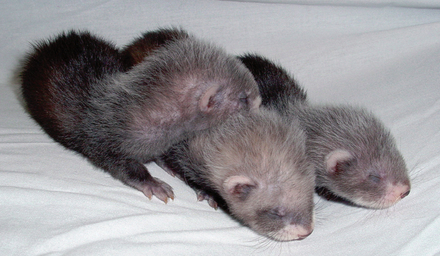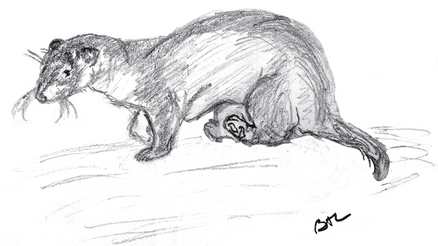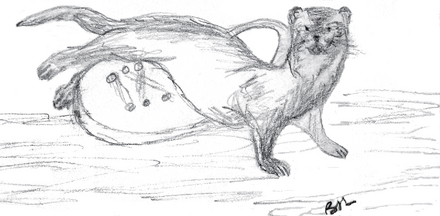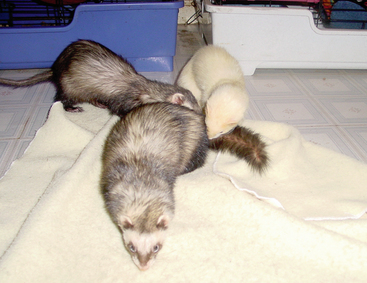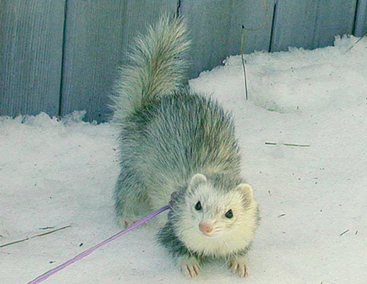CHAPTER 4 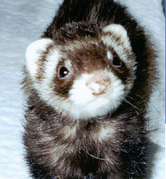 FERRET BEHAVIOR
FERRET BEHAVIOR
Natural Behavior and Domestication
The question as to why ferrets were domesticated may be more easily answered than when the domestication process took place and from what molecular phylogeny. This is in part because of the scarcity of written records from 2000 years ago and because of difficulties in identification of which species was actually being domesticated. Vernacular names for the animal we presume to be the ferret frequently varied from geographic district to district, and ancient scientists may have added to the confusion with incorrect translations from one language to another.43
Domestication is the process by which human selection and control of breeding results in an animal that provides a service or product that is beneficial to humans. With time, domestication results in physical and physiologic changes from the ancestral species. Animals are domesticated for work, food, or materials for clothing and shelter. Ferrets were in all probability originally used by man to control vermin. The earliest written account of an animal that fits the description of our domesticated ferret dates back to the Greek satiric writer Aristophanes (448-385 BC), who used the term “house ferret” in several of his plays to satirize political opponents. Soon thereafter, in 350 BC, the Greek philosopher and naturalist Aristotle (384-322 BC) also made written reference in a treatise on animals and physiognomy to a polecat that “resembles a weasel; and becomes very mild and tame.”43 It is reasonable to suppose he was referring to the ferret, and the demeanor of the animal described implies a close association with people. These early written accounts coincide with the time (circa 300 BC) when agriculture began to take hold in the civilized regions of the northern Mediterranean region centered around present-day Greece. One theory suggests the Greeks domesticated the indigenous European polecat (Mustela putorius) in order to protect grain stores from rodent infestation much in the way the Egyptians domesticated the cat.
Completely carnivorous, the polecat (ferret) will take a wide variety of prey, including hares, rabbits, mice, voles, and rats. The efficiency with which the ferret hunts rabbits brought it into favor with people. Strabo (63 BC–24 AD), a Greek historian, philosopher, and geographer, reported that the Romans used ferrets to control the overpopulation of rabbits on the Balearic Islands: “The ferrets with their claws drag outside all the rabbits they catch, or else force them to flee into the open, where men, stationed at the hole, catch them as they are driven out.”43 By the Middle Ages, man was ferreting rabbits throughout Europe and Asia (Figure 4-1).

Figure 4-1 Ferreting in the Middle Ages—approximately 1300 AD.
(From Thompson AD: A History of the ferret, J Hist Med 6(4):471-480, 1951.)
It is believed ferrets were brought to the United States in the late eighteenth century and used to control shipboard vermin on long, transatlantic crossings.37 In the mid nineteenth century ferrets were bred for their fur, a practice that continued late into the twentieth century. Only recently has fur production fallen out of favor in much of the world.
Ferrets have been kept as companions by historical figures such as Genghis Khan and Queen Elizabeth I; however, their popularity as pets did not increase until the late 1960s. This resulted in additional physical and behavioral changes as ferrets were bred for greater docility, decreased odor, preferred body confirmation, coat color, and failure to thrive in the wild. The last half of the twentieth century also saw the domestic ferret grow in popularity as a laboratory and research animal.
This ferret domestication timeline brings us to the present day, but the precise parent species of the domestic ferret remains uncertain. Ferrets may have been domesticated from the European polecat or from its eastern congener, the steppe polecat (Mustela eversmannii), which has more similar morphology of the cranium. Because M. putorius and M. eversmannii are occasionally reported to hybridize where they overlap in their distribution, the reality of a true species split has been debated, and several authors have at least considered whether M. putorius, M. eversmannii, and the endangered Mustela nigripes from North America (black-footed ferret) could be viewed as one Holarctic species.13
Regardless, in 1758 the domestic ferret was classified by Linnaeus as a separate genus and called Mustela furo. At that time it was believed that the steppe polecat was the most closely related to the domestic ferret. In 1970, through the examination of external chromosome shape, it was determined that the European polecat was closer to the domestic ferret than the steppe polecat. When this evidence came to light it was decided M. putorius and the domestic ferret were one and the same species, and the domestic ferret was then renamed M. putorius furo to distinguish it from the polecat.5
In 1998 Davison and co-workers13 used mitochondrial DNA sequencing to investigate polecat genetic diversity in Britain. Molecular genetics, however, did not resolve whether ferrets were originally domesticated from M. putorius or M. eversmannii. The degree of nuclear introgression* of domestic ferrets and polecats may be so extensive as to rule out ever tracing their wild ancestors.
It must be emphasized that the behavior of domesticated animals in captivity differs from that of tamed wild animals and that these behavioral differences have arisen as a result of selection by humans.5 The exact form taken by such selection will, however, depend on the role of the particular domesticated animal in relation to people. Behaviorally there are major differences between domestic ferrets and the ancestral polecat. Polecats tend to be solitary and very territorial with fighting between males having been observed, presumably over territory and sexual domain. The domestic ferret on the other hand is very social and gregarious, enjoying play activities with conspecifics and preferring to sleep with other ferrets of the same or opposite sex.
The polecat is quick, nervous, and easily frightened and will show fear of people if left with the mother during the critical period of 7½ to 8½ weeks of age.34 The domestic ferret, however, was initially kept as a pest destroyer, normally raised in confinement and liberated to the field in order to hunt the intended prey. Therefore these ferrets were raised to be easily handled and could not be nervous or fearful of humans. Further resemblance and disparities between the domestic ferret and the wild polecat will be made in other sections of this chapter as we investigate the behavior of today’s pet ferret.
Sensory Behaviors
Vision and Behavior
Ferrets have binocular vision, and although they can swivel their eyes to look at different objects, most ferrets look forward and turn their heads to see things to the side. The pupil is horizontally slit, which is common in species that chase prey with gaits characterized by a hopping motion39 and explains the ferret’s fascination with a bouncing ball. Ferrets have very good visual acuity at close range, which is important because the ferret uses varying body language and visual displays to communicate.28 They see less detail at greater distances and as a result pay more attention to complex visual stimuli such as moving objects.
Hearing and Behavior
The ear canals of a ferret do not open until approximately 32 days postnatally (as compared with 6 days in a cat), which coincides with the appearance of a startle response to loud hand claps and the recording of acoustically activated neurons in the midbrain (Figure 4-2).31 This late onset of hearing may explain why kits produce exceptionally loud, piercing sounds during the first 4 weeks of life. Lactating jills are tuned in to kit vocalizations and will respond to high-frequency (greater than 16 kHz) sounds in a maze test, whereas males and nonlactating females will ignore these sounds.39 Adult ferrets hear best when sounds are within a range of 8 to 12 kHz.39 This may explain why ferrets love squeaky toys, which produce sounds in this range.
Olfactory Behaviors
Kits of wild polecats have a critical period of learning the scent of prey (olfactory imprinting), which according to Apfelbach (1986) is between 60 and 90 days of age.1 Except under duress, polecats will refuse to eat any prey whose smell they have not learned by that time.39 As adults, they will actively search for prey with which they were familiarized during this critical time period and will ignore other prey or food smells. This may explain why certain ferrets will eat only one type of diet and why kits exposed to only one brand of food at 60 to 90 days of age may be opposed to dietary changes later in life. It is therefore recommended that young kits be offered a variety of foods during their first 6 months of life in order to prevent dietary selectivity or olfactory imprinting.
The sense of smell in ferrets is particularly keen. Wild mustelidae hunt down their prey using their sense of smell to home in on the quarry. During exploratory behavior the ferret spends a great deal of time with its nose to the ground investigating its environment. Objects placed directly in front of a ferret will be examined first by smelling, followed by visual or tactile inspection.
Communication Behaviors
Olfactory Communication
Polecats are a solitary species and leave marks throughout their home range by performing a repertoire of scent-marking actions that include wiping, body rubbing, and the anal drag (Figures 4-3 and 4-4).10 Observations of ferrets in an outside enclosure revealed that anal drags were performed at latrines near den sites and at an equal frequency by males and females throughout the year.10 Mustelidae also use urine for scent-marking and produce skin oils that are profoundly affected by circulating hormone levels. Hobs (male ferrets) in particular will produce intense seasonal skin oils that correspond to the increased testosterone levels associated with longer day lengths.
Ferret anal scent gland odors are sexually dimorphic, and studies have demonstrated that ferrets can use these variations as a communication tool.11 Ferrets can distinguish between male and female anal sac odors, among strange, familiar, and their own odors, and between fresh and 1-day-old odors.11 These results are consistent with both a sex attraction role and a territorial defense role for anal sac odors.
Different messages are conveyed by the various marks. Kelliher and Baum22 showed that in the ferret, olfactory detection and processing of volatile odors from conspecifics is required for heterosexual mate choice.22 Males perform more body rubbing than females (jills), especially during the breeding season. Anal drags leave an olfactory signature of anal sac secretion for intersexual and intrasexual communication. Olfactory marking behavior also communicates territoriality and gives other ferrets knowledge of the marking ferret’s sex and hormonal activity. Wiping and rubbing actions release the ferret’s general body odor and may act as a threat signal in agonistic encounters.10
The response to olfactory stimuli and the scent-marking behavior of domestic ferrets is much less pronounced than that of their undomesticated counterparts. Domestic ferrets retain the actions of marking that are so important to their wild relatives.39 The ferret thrives in the company of other ferrets; readily sharing living quarters, hammocks in which they sleep, food bowls, and water bottles. Despite this harmony, ferrets are still instinctively territorial and lay claim to smaller, albeit significant territories within their home environment. Like the wild polecat, domestic ferrets back up and defecate on objects or certain areas (and some even anal drag after defecation) in order to mark their territory. The domestic ferret tends to choose corners in which to defecate that may represent territory perimeters.
When it comes to the postdefecation anal drag, operators of ferret shelters will note that this behavior will increase in some ferrets when a new ferret is introduced to the household or when ferrets become more seasonally hormonal.25 This innate behavior occurs even in ferrets that are surgically descented (anal sacculectomy), as the ferret is unaware of its missing anatomy. Ferrets also possess perianal sebaceous glands that secrete oils used in scent-marking. The strength of the scent from these glands is reduced in neutered males.
Worth mentioning is the way in which ferrets use their sense of smell in meet-and-greet behavior. When ferrets are introduced they will often sniff each other’s anal area and neck and shoulder region (Figure 4-5). This behavior may give a domestic ferret information about the other ferret’s sex and hormonal status. This activity may be the domestic ferret’s equivalent of the behavior in the wild counterpart by which sexual receptivity is assessed.
Vocalizations
Although quiet most of the time, domestic ferrets do make a variety of vocalizations with which they communicate. In order to determine the meaning of ferret sounds, Shimbo39 recorded waveforms and sound spectrographs of various domestic ferret vocalizations. Interpretation of these auditory studies led to several generalizations such as an increase in tonality on a basic signal indicates heightened excitement, a rising inflection indicates urgency, and a rising pitch of a string of sounds indicates displeasure.39 Any one or more of these alterations in inflection can be superimposed on any vocalization to alter its meaning. The following are descriptions and the interpretive significance of the most common ferret vocalizations as recognized by many ferret owners.
Scream
A high-pitched screech is used when a ferret is startled, frightened, or in pain. When cornered by another animal, ferrets may scream to startle their opponent and thereby gain escape. Prolonged screaming is an indication that something is seriously wrong and may occur when a ferret is in intense pain; such screaming has also been reported to occur during seizures.6 All cases of continual or recurrent screaming warrant a medical workup.
Visual
Ferrets also use body language and a variety of visual displays to communicate moods and feelings. They prefer to follow and attack prey moving at a velocity close to the escape speed of a mouse.45 This may help to explain their fascination with bouncing balls, toys pulled along the ground in front of them, and in general anything that moves. During exploration the inquisitive ferret will periodically demonstrate scouting behavior in the form of erect or alert posturing. This attention response is similar to (and probably stems from) actions shown by the European polecat while investigating unfamiliar surroundings. During this response the neck is raised, the head is held at 90 degrees to the body, the ears are pricked, and the vibrissae are extended.39
Piloerection in the form of a frizzed-out tail may be a sign of anger or excitement, either fearful or joyous (Figure 4-6). During a display of anger, the puffed tail is usually accompanied by an arched back and a vocal hiss or screech. If the display represents excitement and joy, the tail may fuzz out and flick back and forth. Piloerection of the tail may also be noted during an anaphylactic reaction such as that seen with a vaccine reaction.
Locomotor Behaviors and Activity
Normal locomotion in a ferret consists of alternating movements of all four feet, although a ferret can be seen to hop or gallop with the rear legs when running or at play. Many repeatable locomotor patterns can be noted that tell us the ferret is a happy, playful pet; these activities have been described and nicknamed by ferret owners.37 For example, the “dance of joy” or the “weasel war dance” is exhibited by the ferret that is happy and excited. The animated ferret tries to go in several directions at once; dancing from side-to-side, hopping forward, twisting back, flipping and rolling on the floor—all at an energetic pace. There seems to be no apparent reason for this dance other than pure joy and happiness.
The “alligator roll” is a form of intense play or wrestling between two ferrets where one ferret grabs the other by the back of the neck and flips him upside down. Some feel this is a way for one ferret to show dominance.6 Because wild ferrets are solitary, any form of social hierarchy would be a reflection of domestication and the housing of multiple unrelated ferrets in close captivity. It is obvious that ferrets are energetic, fun-loving animals. As a result of this high energy, ferrets need ample play time (preferably up to 2 hours per day) and benefit greatly from environmental enrichment.
Elimination Behaviors
Once satisfied with the spot, the ferret will turn around, back into the corner, and, with back slightly arched and tail raised directly over the back, defecate using slight pulsing contractions of the abdomen. Ferrets do not bury their stool but will at times perform a postdefecation anal drag in which they scoot their anus along the floor for a few seconds. When urinating the ferret behaves similarly to find the appropriate site, it then squats with the rear legs spread slightly apart. The urination posture of both males and females is similar, with the only difference being that females squat slightly lower. Ferrets have an innate love for digging, and a clean litter box is a perfect setting for digging and play behavior, often resulting in an unused, tipped-over litter box. See Box 4-1 for litter box tips.
BOX 4-1 Litter Box Tips
Reproductive Behaviors
Researchers have shown that both estrogen and testosterone contribute to masculine sexual behavior in male ferrets8 and female ferrets.41 Ferret hormonal activity is strongly influenced by endogenous circadian rhythms, which persist under conditions of constant light and constant darkness. However, these circadian rhythms are usually influenced by external factors such as light, temperature, barometric pressure, and hormones.20 Of these factors the most important is light, and ferret sexual behavior becomes more evident as natural day lengths increase. As day lengths increase, circulating melatonin levels diminish and hypothalamic gonadotropin-releasing hormone (GnRH) is released in a pulsatile fashion, in turn resulting in the release of pituitary luteinizing hormone (LH) and follicle-stimulating hormone (FSH), which stimulate the release of estrogen and testosterone from the gonads.38 This results in an increase in sexual activity and interest.
Male Reproductive Behaviors
The onset of puberty in hobs is denoted by development of male sexual behaviors such as showing more interest in jills and the introduction of neck gripping and pelvic thrusting into their play behavior. If exposed only to natural lighting, the hob will become reproductively active a full 1 to 2 months before the jill.18 A testosterone surge will result in reproductive behaviors associated with attracting the opposite sex and protecting territory.
Hobs in rut will be more aggressive and will scent-mark in order to get the message across to potential breeding partners that they are ready to mate. Male ferrets have preputial gland secretions that they will wipe on objects by dragging their bellies across the ground. Perianal scent glands are also used for scent-marking by dragging the anus or scooting across the ground (anal drag). Numerous dermal sebaceous glands, most prominent at the nape of the neck, are used by rubbing and rolling onto inanimate objects hobs wish to mark. Males have more sebaceous glands than females, and glandular production appears to be under androgenic control.32 In a natural setting all these reproductive behaviors would allow multiple polecat hobs to stake their territory and fight off any potential competitive male suitors so that by the time the jill becomes sexually receptive they can get down to the business of breeding.
During the mount, the male grabs the nape of the jill’s neck with his teeth and will grip her body by wrapping his forelegs around her ribcage. Pelvic thrusts last variable lengths of time up to 3 minutes. Between pelvic thrust bursts are periods of rest during which the male simply lies over the female and holds on with the neck grip. At the point of penetration the male will increase the arch of his back anteriorly, causing his foreleg grip to slip behind the female’s rib cage.30 Holding this position for a variable but usually prolonged period of time is the best interpretation of penetration, at which time pelvic thrusting ceases. Occasionally the male will tense his pelvis, causing the tail to raise for short periods of time. At this time the female will occasionally flinch or remain flaccid.30
Variable mating times from 120 minutes to 3 hours have been reported, but in one study mating times recorded in 10 pairs of ferrets lasted from 34 to 172 minutes.30 These prolonged intromissions appear necessary in order to ensure fertilization. Whether this is to allow for increased sperm deposition as a result of the multiple ejaculations of the male or if it is necessary to stimulate the LH surge and subsequent ovulation in the female is open to debate. Neutered males with adrenal gland disease may display sexual behavior because of production of testosterone by the abnormal glands (see the discussion of adrenal disease).
Female Reproductive Behaviors
Behavioral changes associated with rising estrogen levels and puberty in the female ferret are less pronounced. Some jills may show evidence of being more excitable and nervous, whereas most show no behavioral changes at all. Wheel-running activity was shown to increase during estrus, with the number of wheel revolutions being doubled or tripled as compared with totals in ovariohysterectomized or anestrus ferrets.14 With the onset of full estrus, food intake may decrease and jills may sleep less and become irritable.18 Before onset of full estrus, jills will be unresponsive to the advances of a hob in rut. There will be a good bit of anal, genital, and neck sniffing, nose poking, and attempts by the male to grab the female by the neck, but the jill will ignore this behavioral foreplay or when tired of it hiss and nip or attack the male.
Social and Antisocial Behaviors
As a general rule, patterns of behavior and social relationships are developed through learning as well as heredity, and social animal groups are organized by social status, territoriality, and reproductive activities. The interplay of experience and innate* factors in the development of behavior is very subtle and can be difficult to separate.16
European polecat kits are dependent on their mothers to bring them meat meals from the time they are weaned at 6 to 8 weeks to the time they begin to hunt on their own at 10 weeks of age. During this preweaning time kits have been observed to interact socially and play.24 However, by the time they are 13 weeks old, a time when kits may leave their nests permanently and go out on their own, kits show various degrees of independence from one another.24 Adult polecats are essentially solitary, with one study finding ferrets to share dens simultaneously with other ferrets on only 7.4% of 706 radio-tracking events.36 Also, adult ferrets demonstrate intrasexual territoriality, with dominant males showing more spatial overlap with females than with subordinate males.29
The domesticated ferret, on the other hand, shows much more diurnal activity, and many can be kept in pairs or groups without conflict. The best explanation for the difference in socialization patterns is that familiarization and habituation* play a significant role in the ferret’s social response to both man and conspecifics. Familiarization in the form of imprinting may be involved as young polecats removed from their mothers during this critical phase in their development (4 to 10 weeks) become imprinted on their human caretakers. Evidence to support this belief is the fact that young polecats follow their mother on foraging expeditions and that hand-reared ferrets readily follow a human being. It has also been shown that the presence of the mother appears to facilitate the development of fear of humans in the young.34 In captivity, however, fear of humans does not develop in wild polecats if they are removed from their mother at any time before the second day after their eyes have opened (typically 28 to 34 days).34 Socialized ferrets are also more likely to show habituation than isolated ferrets,9 demonstrating that socialization and domestication go hand in hand. Pet ferrets acclimate to their environment and will rise to the occasion when given an opportunity to play, explore, or interact with others. In other words, they become diurnal as their periods of activity coincide with that of their human household.
Pet ferrets readily show affection for their human owners through gleeful greeting behavior and willingness to shower owners with ferret kisses. Young ferrets, on the other hand, are not likely to enjoy quiet cuddle time. Their exploratory behavior creates too strong an urge to get off an owner’s lap and move on to investigate the environment around them. As ferrets mature, a combination of age, improved socialization, and a decrease in exploratory behavior results in a more staid ferret that enjoys periods of quiet snuggling and petting.
Stay updated, free articles. Join our Telegram channel

Full access? Get Clinical Tree


